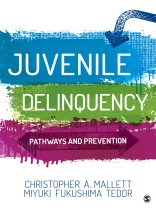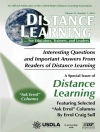‘This textbook is an excellent tool that explores issues impacting juvenile delinquency, theories, system response, community interventions, and effective programs to help reduce delinquency.’
—Robbin Day Brooks, MSW, CPP, Arizona State University’s School of Criminology & Criminal Justice
Juvenile Delinquency: Pathways and Prevention explores the pivotal roles that family, trauma, mental health, and schools have on juvenile delinquency, while exploring opportunities for prevention and intervention. Authors Christopher A. Mallett and Miyuki Fukushima Tedor draw from years of experience working with juvenile offenders to shed light on the nature of delinquency and the diverse pathways to juvenile delinquency, while offering evidence-based techniques for preventing and rehabilitating youthful offenders. Clear explanations of the concepts and thought-provoking case studies move students beyond memorization—encouraging them to think critically about juvenile delinquency and make recommendations for better practices and policies.
Give your students the SAGE edge!
SAGE edge offers a robust online environment featuring an impressive array of free tools and resources for review, study, and further exploration, keeping both instructors and students on the cutting edge of teaching and learning.
Daftar Isi
Preface
About the Authors
PART I: JUVENILE JUSTICE SYSTEM
Chapter 1. The Functioning of the Juvenile Justice System
Learning Objectives
Introduction
Juvenile Courts
Juvenile Court Purpose
Juvenile Court Jurisdiction
The Process of the Juvenile Justice System
The Child Welfare System
CHAPTER SUMMARY
KEY TERMS
DISCUSSION QUESTIONS
Chapter 2. The History of Juvenile Justice and Today’s Juvenile Courts
Learning Objectives
Introduction
Juvenile Justice: Cycles of Rehabilitation and Punishment
Today’s Juvenile Court Reform
CHAPTER SUMMARY
KEY TERMS
DISCUSSION QUESTIONS
Chapter 3. The Measurement of Juvenile Crime
Learning Objectives
Introduction
Official Data
National Crime Victimization Survey
Juvenile Delinquency
CHAPTER SUMMARY
KEY TERMS
DISCUSSION QUESTIONS
PART II: THEORIES OF DELINQUENCY
Chapter 4. Classical, Biological, and Psychological Theories of Crime
Learning Objectives
Introduction
Preclassical and Classical Theories of Crime
Early Biological Theories of Crime
Early Social Structural Theories
Modern Biological Perspectives
Modern Psychological Theories
CHAPTER SUMMARY
KEY TERMS
DISCUSSION QUESTIONS
Chapter 5. Modern Sociological Theories of Crime
Learning Objectives
Introduction
Strain/Anomie Theories
Social Disorganization Perspective
Learning Theories
Subcultural Theories
Control Theories/Neoclassical Criminology
Modern Classical Perspective
Social Reaction, Critical, and Feminist Theories
Life-Course Perspective
CHAPTER SUMMARY
KEY TERMS
DISCUSSION QUESTIONS
PART III: PROBLEMS THAT LEAD TO DELINQUENCY
Chapter 6. Delinquency Risks and Disproportionate Impact
Learning Objectives
Introduction
Factors That Influence Delinquency
Ecological/Psychosocial Model
School Discipline Risk Factors
Delinquency Risk Factors
Protective Factors
Resiliency
Disproportionate Impact
Maltreatment and Trauma Victims
Lesbian, Gay, Bisexual, and Transgender Students
Why the Disproportionate Impact?
CHAPTER SUMMARY
KEY TERMS
DISCUSSION QUESTIONS
Chapter 7. Punitive Juvenile Justice Policies
Learning Objectives
Introduction
Adolescents Are Different Than Young Adults
From the Classroom to the Courts
The Police and Adolescents
Delinquency Adjudication
Detained and Incarcerated Youthful Offenders
CHAPTER SUMMARY
KEY TERMS
DISCUSSION QUESTIONS
Chapter 8. School Violence, Zero Tolerance, and School Exclusion
Learning Objectives
Introduction
Compulsory Education and Student Discipline
School Discipline in the Zero Tolerance Era
School Discipline
CHAPTER SUMMARY
KEY TERMS
DISCUSSION QUESTIONS
Chapter 9. Trauma and Delinquency
Learning Objectives
Introduction
Prevalence of Childhood and Adolescent Trauma
Post-Traumatic Stress Disorder (PTSD)
Resiliency to Trauma Experiences
Maltreatment and Academic Performance
Maltreatment and Delinquency
CHAPTER SUMMARY
KEY TERMS
DISCUSSION QUESTIONS
Chapter 10. Mental Health Disorders, Special Education Disabilities, and Delinquency
Learning Objectives
Introduction
Child and Adolescent Mental Health Problems
Mental Health and Trauma
Juvenile Incarceration: Today’s Psychiatric Asylums
Disabilities Rights
CHAPTER SUMMARY
KEY TERMS
DISCUSSION QUESTIONS
PART IV: SOLUTIONS TO DELINQUENCY
Chapter 11. Evidence-Based Delinquency Risk Prevention
Learning Objectives
Introduction
Maltreatment Victimization
Prevention
Mental Health Problems
CHAPTER SUMMARY
KEY TERMS
DISCUSSION QUESTIONS
Chapter 12. School Safety and Inclusion Policies
Learning Objectives
Introduction
Students, Classrooms, and Schools
Moving Away From Zero Tolerance Policies
Rehabilitative and Supportive Interventions
Truancy Prevention
School Dropout
School Districts
State Policies
National Policies
CHAPTER SUMMARY
KEY TERMS
DISCUSSION QUESTIONS
Chapter 13. Rehabilitation of Low-Level Youthful Offenders
Learning Objectives
Introduction
Effective Framework
Delinquency Prevention
Diversion
Assessment
Community-Based Corrections
CHAPTER SUMMARY
KEY TERMS
DISCUSSION QUESTIONS
Chapter 14. Rehabilitation of Serious and Chronic Youthful Offenders
Learning Objectives
Introduction
Juvenile Justice: A Developmental Framework
Detention Reform
Incarceration
Reentry and Return Home
Gang Membership and Prevention
Addressing Racial and Ethnic Disparities
CHAPTER SUMMARY
KEY TERMS
DISCUSSION QUESTIONS
Glossary
References
Index
Tentang Penulis
Miyuki Fukushima Tedor is an associate professor in the Department of Criminology, Anthropology, and Sociology at Cleveland State University. She received B.A. degrees in philosophy, psychology, and sociology and a M.A. and a Ph.D. in sociology. Her research has focused on cross-national testing of theories of crime and delinquency, gender and crime, juvenile delinquency, and drug and alcohol use and crime. She has taught in these areas for many years. Professor Tedor is originally from Japan and enjoys talking to her students about what it was like growing up in Japan.












